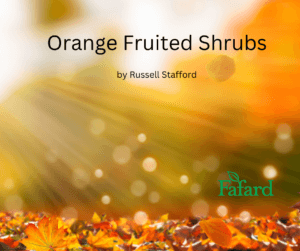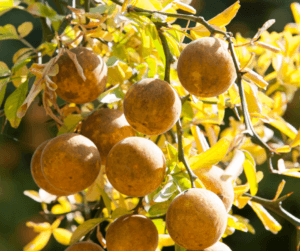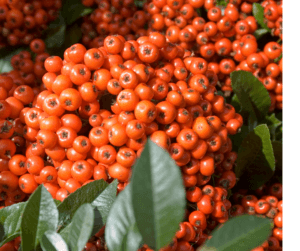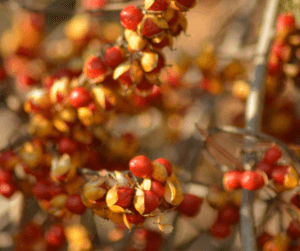
It’s the season of orange. Orange leaves deck the trees. Orange pumpkins haunt porches. Containers of orange chrysanthemums throng walkways.
So why not plant a few orange-fruited shrubs to bring the Halloween theme into the garden?
Poncirus trifoliata takes “orange-fruited” quite literally – so much so that botanists have moved it to the genus Citrus. Going by the entirely apropos common name of hardy orange, this 6- to 8-foot shrub produces numerous 2-inch-wide, spherical mini-citrus that ripen orange-yellow in fall. Their hyper-tart taste will make you pucker, unless of course you make them into something sweeter such as jelly or candied orange rind (numerous recipes are online). Hardy orange is much more than a one-season-Charlie, however. In early spring it covers itself with fragrant white flowers, larger than those of most citrus. Its dark green three-fingered leaves emerge shortly thereafter, looking handsome through the growing season and turning burnt-orange hues in fall. As for “hardy”, it takes that literally too, wintering into warmer pockets of USDA Zone 5 (full sun to light shade preferred). The species (and its sinuous-stemmed ‘Flying Dragons’ form) would doubtless be much less rare in Eastern and Midwest landscapes if more gardeners had a clue that a hardy citrus does actually exist.

Winterberry (Ilex verticillata) sets eastern and central U.S. wetlands ablaze in autumn with its fiery fruit. Borne in dense clusters at the branch tips, the bead-like berries are usually bright red – but sometimes they opt for shades of orange. Full-sized (8- to 10 foot) cultivars that have gone to the orange side include red-orange-fruited ‘Afterglow’ and orange-yellow ‘Winter Gold’. The recently introduced ‘Little Goblin’ bears mid-orange fruits on compact, 4-foot plants. Winterberry’s Southern cousin, possumhaw (Ilex decidua), also has orange-fruited forms including ‘Byer’s Gold’. All fruiting Ilex are female selections that won’t produce berries without a male Ilex nearby. Bloom time varies among cultivars, so you’ll need a male/female pair that flowers at the same time in spring. Lists of suitable pairings can be found online. If your garden is sandy, plants will benefit from an application of a peat-rich compost such as Fafard® Premium Natural & Organic Compost, to give them moist acidic soil they prefer. Sunny sites in hardiness zones 3 to 8 work best (zones 5 to 8 for possumhaw).

Orange-fruited varieties of American holly (Ilex opaca) and English holly (Ilex aquifolium) also occasionally occur, but none are readily available in the horticultural trade at this time.
Linden viburnum (Viburnum dilatatum) flaunts large flat clusters of blood-red berries in fall – except in the case of the newly introduced cultivar ‘Tandoori Orange’. Like most viburnums, it won’t fully fruit unless a different variety of its species is nearby. All Viburnum dilatatum cultivars grow fairly rapidly to 8 feet tall and wide or more, so plan and plant accordingly! Their bold pleated foliage contrasts effectively with finer-textured plants such as mountain ashes (Sorbus spp.) and cutleaf lilac (Syringa protolaciniata).
Tea viburnum (Viburnum setigerum) is another typically red-fruited viburnum that occasionally goes orange, as in the case of cultivar ‘Aurantiacum’. Rather lanky and narrow in habit, this 8-foot-tall, 6-foot-wide shrub is spectacular in fruit, more than compensating for its ungainliness. It’s best planted amid more compact shrubs, to cover its bare legs. All the above viburnums favor sun and hardiness zones 5 to 8.
Strawberry shrub (Euonymus americanus) makes an excellent subject for naturalistic plantings. Occurring as a somewhat scrawny, thicketing, 4- to 6-foot shrub in its native woodland haunts in the central and eastern United States, it grows more densely in lightly shaded garden niches with good soil. Most of the year it’s a relatively anonymous euonymus, with presentable oval leaves and inconspicuous spring flowers on arching to upright green-barked stems. It becomes a real attention-grabber in fall, however, brandishing warty rose-red fruit capsules that open to reveal large fleshy bright orange seeds nested inside. For more “domesticated” garden areas there’s the East Asian native Euonymus planipes, a much larger plant than strawberry shrub (10 feet or more), with considerably larger capsules and seeds to match. Some exotic euonymus such as burning bush (Euonymus alatus) European spindle tree (Euonymus europaeus) have proven invasive in American landscapes; consult your local invasive species lists before taking one on board. Most euonymus are hard to zone 5.
American bittersweet (Celastrus scandens) can be grown as a twining vine, or alternatively as a scrambling shrub (sunny or lightly shaded niches in zones 4 to 8 are preferred). A member of the same family as Euonymus, it bears similar fruit, although in a reverse color scheme, with orange capsules opening to red seed. Plants are mostly male or female, with at least one of each required for a good fruit display. This meritorious U.S. native is not to be confused with the exotic invasive Asian bittersweet (Celastrus orbiculatus), which is banned in most states. American bittersweet has toothed leaves and bears fruit at the branch tips; Asian bittersweet has wavy-edged, untoothed leaves and axillary fruit.

Happy planting, and Happy Halloween!

